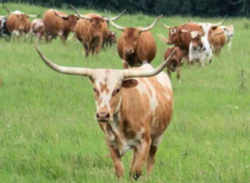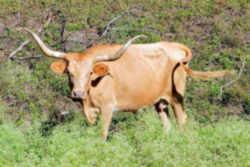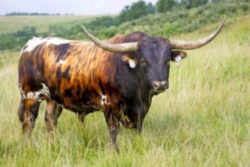
Texas Symbols
Texas State Large Mammal
Longhorn

(Bos bos)
Adopted on June 16, 1995.
The Longhorn, (Bos bos,) was adopted on June 16, 1995 as the Texas Large Mammal.The longhorn became the official large state
when Governor George W. Bush signed House Concurrent Resolution No. 178. The same resolution named the armadillo the
official small state mammal of the State of Texas.
Also in 1995, a third mammal was named to represent Texas when Senate Concurrent Resolution No. 95 was signed. The Mexican
free-tailed bat was named the official flying mammal of the State of Texas.
Longhorn, the hardy breed of open range cattle that defined the western trail drive and serves as the mascot for the University of Texas. Once severely reduced in numbers, a renewed interest in their preservation and breeding has re-established several large herds. One of these is under the stewardship of the Parks and Wildlife Department and owned by the State of Texas.
Texas State Large Mammal: Texas Longhorn

Amigo Yates, a longhorn on the Yates Ranch south of Abilene, currently has the largest horn spread in the world - 103 inches.
In 1936 Sid Richardson, a Fort Worth businessman, believed we were about to lose the Texas Longhorn. In fact, he thought the Texas Longhorns were closer to extinction than the buffalo. He discussed the possibility of assembling a State Longhorn herd with long time Texas Historian J. Frank Dobie. Mr. Richardson would provide the funding and Dobie would find and select the longhorns. Dobie enlisted the help of long time cattle detective, rancher and longhorn raiser, Graves Peeler.
They traveled through out South Texas and by 1941 had selected twenty head. Now they needed a place to put them. The Texas Parks and Wildlife Department eagerly sought the responsibility of protecting and preserving this State historic treasure. The longhorns were placed at Lake Corpus Christi State Park.
Richardson then asked Dobie and Peeler to locate another herd. It was difficult to find more; they had to drive hundreds of miles and both sides of the Rio Grande.
By the end of 1942, they had located a few more and these were placed at Lake Brownwood State Park. In 1948, all the longhorns were rounded up. Twenty-one were shipped to Fort Griffin State Park and the remaining ones were sold. Since that time, the longhorns have been one of the greatest assets at Fort Griffin, drawing visitors from all over the world.
Since its inception, this has been the Official State Longhorn herd and Fort Griffin the home of the herd, since 1948. The Texas Legislature recognized the herd with Senate Concurrent Resolution No. 79 adopted May 17, 1969. Fort Griffin places Longhorns in other state parks for exhibition, range management, and breeding purposes.
History of the Texas Longhorn

The Texas Longhorn became the foundation of the American cattle industry by claiming first rights in the untamed, newly discovered Americas a little over 500 years ago. In 1493, Christopher Columbus brought Spanish cattle to Santa Domingo, and within two hundred years their descendents would be grazing the ranges of Mexico.
In 1690, the first herd of cattle, only about 200 head, were driven northward from Mexico to a mission near the Sabine River-a land that would become known as Texas. The early missions and ranchers would not survive all of the elements. But the Texas Longhorn would.
By the time of the Civil War, nearly 300 years after setting foot in America, millions of Longhorns ranged between the mesquite-dotted sandy banks of the Rio Bravo to the sand beds of the Sabine. Most of the Longhorns were unbranded, survivors of Indian raids, scattered by stampedes and weather, escaped from missions or abandoned after ranch failures.
The survivors of the Civil War returned home to Texas to find abandoned ranches, unplowed farm fields- and herds of wild cattle, which would soon become gold in their pockets. In the next quarter century, 10 million head were trailed North to fatten on lush Midwestern grasses or shipped directly by rail to the beef-hungry East.
Translating wild cattle into hard cash was an epic struggle between man, beast and the elements- from this grew the romantic legends of the Western Cowboy.
Longhorns, groomed by Mother Nature, carried the ideal characteristics of resistance- they were tremendous for long drives. They could go incredible distances without water, rustle their own food, fend for themselves, swim rivers, survive the desert sun and winter snow.
But, at the turn of the century, sundown came for the Texas Longhorn. It took less than 40 years, fenced in land, plows and an overwhelming demand in the marketplace to drive the Longhorn closer to extinction than the buffalo.
In 1927, the Federal government helped to preserve the Texas Longhorn and a great part of our American heritage. With only a handful of Texas Longhorns roaming the ranges in private herds, Congress appropriated $3,000, and assigned forest service vice rangers, Will C. Barns and John H. Hatton to the task.
These two men put the first herd together for Wichita Mountains Wildlife Refuge in Oklahoma. Another herd was established on the Fort Niobrara National Wildlife Refuge at Valentine, Nebraska. Also, at this time, the early 30s, the State of Texas formed its own herd with the help of J. Frank Dobie, author of The Longhorns, and his friend Graves Peeler, who had excellent knowledge of the Texas range country.
Characteristics of the Texas Longhorn
Name: Texas Longhorn
Scientific name: Bos bos
Range: Southwestern and Midwestern United States Grasslands
Habitat: Open Grassland
Status: Not threatened
Diet in the wild: Prarie Grass
Diet in the zoo: Herbivore Diet
House Concurrent Resolution No. 178, 74th Legislature, Regular Session (1995)
H.C.R. No. 178
HOUSE CONCURRENT RESOLUTION
WHEREAS, The State of Texas traditionally has recognized a variety of official state symbols as tangible representations of the proud spirit and heritage
of our state; and
WHEREAS, The bluebonnet, the pecan tree, the Guadalupe bass, and the lightning whelk are examples of some natural specimens that serve to symbolize
the great diversity of the Texas landscape, while the state dish, chili, fittingly represents another aspect of our shared culture as Texans; and
WHEREAS, In keeping with this custom, the designation of an Official State Mammal of Texas has been the subject of an extensive statewide mock election
participated in by hundreds of elementary schoolchildren throughout our state; and
WHEREAS, The two front runners in this race have been the armadillo and the longhorn; and
WHEREAS, Once the cornerstone of the Texas cattle industry, an estimated 10 million longhorns were herded from Texas to midwestern and western markets
during the quarter century that followed the Civil War, providing invaluable stability to the state's postwar economy; and
WHEREAS, The longhorn's distinctive profile commands an immediate association with the State of Texas nationwide and is fittingly used as a visual
symbol by businesses from the Rio Grande Valley to the Panhandle; and
WHEREAS, The other candidate for designation as Official State Mammal, the armadillo, is a hardy, pioneering creature that chose to begin migrating
here at about the time that Texas became a state; and
WHEREAS, The armadillo possesses many remarkable and unique traits, some of which parallel the attributes that distinguish a true Texan, such as a
deep respect and need for the land, the ability to change and adapt, and a fierce undying love for freedom; and
WHEREAS, As proud and indomitable as the state from which they hail, both the longhorn and the armadillo will serve as fitting symbols of Texas' unique
heritage; now, therefore, be it
RESOLVED, That the 74th Legislature of the State of Texas hereby designate the longhorn the official Large State Mammal of Texas and the armadillo
the official Small State Mammal of Texas.
Texas Law
The longhorn was named the official large state mammal of the State of Texas by House Concurrent Resolution and is not, therefore,
listed in the Texas Statutes.
Only a few of Texas' myriad symbols were actually adopted by an act of the legislature and written into the Texas Statutes.
Taxonomic Hierarchy: Longhorn
Kingdom: Animalia
Phylum: Chordata
Class: Mammal
Order: Artiodactyla
Family: Bovidae
Subfamily: Bovinae
Genus: Bos - Linnaeus, 1758







